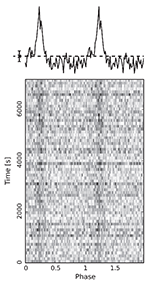Research Notes

Coherently dedispersed average pulse profile (top) and strength as a function of time (bottom) for the 2 hr observation centered on 49 MHz averaged over ~8 MHz of bandwidth. The pulsar is detectable throughout the entire observation.
LWA1 Detects Three Millisecond Pulsars below 100 MHz
The Long Wavelength Array radio telescope has recently made the lowest frequency detections ever of three millisecond pulsars providing strong constraints on their environments.
The Long Wavelength Array radio telescope is a new type of radio telescope being constructed in New Mexico using arrays of dipoles. Pulsars are rotating neutron stars and millisecond pulsars (MPSs) are distinguished from normal pulsars by faster rotation periods and weaker magnetic fields. Operating at wavelengths between 4 and 30 m, the LWA will see the Universe in a new light.
In a recent publication by UNM research professor Jayce Dowell and collaborators, we present results on the pulsar PSR J2145-0750. Using coherent dedispersion we detected pulsed emission between 37 and 85 MHz. From this we derive flux densities and pulse profiles at 41, 57, 65, 73, and 81 MHz.
- We find that the flux density spectrum of PSR J2145-0750 appears to flatten below 100 MHz relative to the spectral index of ~-1.6 found in the literature.
- We also find that the pulse profile shows little evolution over this frequency range and is similar to profiles found at 102 MHz.
- We also discuss the prospects for precision dispersion measure monitoring at these frequencies.
For more information see the article at: iopscience.iop.org/2041-8205/775/1/L28 and the LWA web pages.
Department of Physics and Astronomy
The University of New Mexico
Physics, Astronomy, and Interdisciplinary Sciences building (PAÍS)
210 Yale NE
Albuquerque, NM 87106
505-277-2616
505-277-1520 fax
